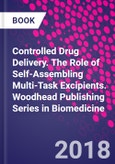In complex macromolecules, minor modifications can generate major changes, due to self-assembling capacities of macromolecular or supramolecular networks. Controlled Drug Delivery highlights how the multifunctionality of several materials can be achieved and valorized for pharmaceutical and biopharmaceutical applications. Topics covered in this comprehensive book include: the concept of self-assembling; starch and derivatives as pharmaceutical excipients; and chitosan and derivatives as biomaterials and as pharmaceutical excipients. Later chapters discuss polyelectrolyte complexes as excipients for oral administration; and natural semi-synthetic and synthetic materials. Closing chapters cover protein-protein associative interactions and their involvement in bioformulations; self-assembling materials, implants and xenografts; and provide conclusions and perspectives.
Table of Contents
- List of figures
- List of tables
- Biography for book
- 1. The concept of self-assembling and the interactions involved
- 1.1 The concept of self-assembling
- 1.2 The nature of forces and types of interactions involved in self-assembly of macromolecules
- 1.3 Hydrogels and their role in drug conception and development
- 1.4 Self-assembling phenomena in solid dosage forms
- 1.5 Conclusions
- References
- 2. Starch and derivatives as pharmaceutical excipients: From nature to pharmacy
- 2.1 General aspects
- 2.2 Structural considerations
- 2.3 Self-assembling in physically modified starches
- 2.4 Chemically modified starches and their self-assembling
- References
- 3. Chitosan and its derivatives as self-assembled systems for drug delivery
- Abbreviations
- 3.1 Introduction
- 3.2 Unmodified chitosan-self-assembled thermogels
- 3.3 Amphiphilic chitosan derivatives
- 3.4 Amphiphilic/amphoteric chitosan derivatives
- 3.5 Conclusion
- References
- 4. Chitosan-based polyelectrolyte complexes as pharmaceutical excipients
- Abbreviations
- 4.1 Introduction to chitosan-based polyelectrolyte complexes
- 4.2 Chitosan-chondroitin sulfate PEC
- 4.3 Chitosan-carboxymethyl starch PEC
- 4.4 Chitosan-dextran sulfate PEC
- 4.5 Chitosan-pectin PEC
- 4.6 Chitosan-alginate PEC
- 4.7 Chitosan complexed with other polysaccharides
- 4.8 Conclusion
- References
- 5. Self-assembling in natural, synthetic, and hybrid materials with applications in controlled drug delivery
- 5.1 General considerations
- 5.2 Natural polysaccharides and their derivatives used in controlled drug release
- 5.3 Self-assembling of synthetic polymers
- 5.4 Hybrid materials obtained by self-assembling
- 5.5 Conclusions
- References
- 6. Protein-protein associative interactions and their involvement in bioformulations
- 6.1 Introduction
- 6.2 Generalities on proteins, their roles, and their possible use as excipients
- 6.3 Albumin microspheres and nanoparticles for drug delivery
- 6.4 Self-assembling processes involving albumin and bioactive agents
- 6.5 Collagen: generalities and utilizations as material for biopharmaceutical applications
- 6.6 Protein excipients for solid dosage forms
- 6.7 Pharmaceutical solid, oral, high-loaded, and gastro-resistant dosage forms of therapeutic enzymes
- 6.8 Gastro-resistant excipient-free pharmaceutical forms of therapeutic enzymes
- 6.9 Conclusion
- References
- Index








